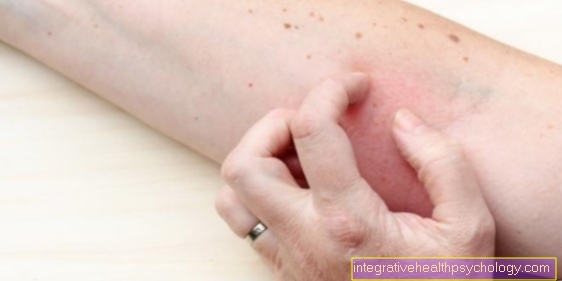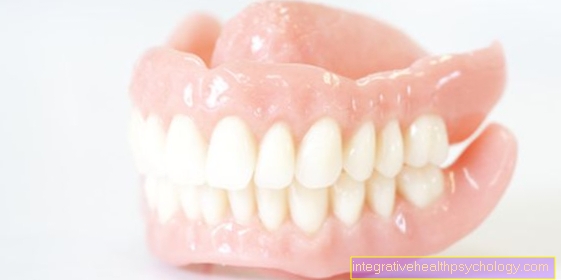rheumatism
introduction
"Rheumatism" is understood to mean all diseases of the so-called rheumatic group, which comprises a total of around 450 different diseases. What they all have in common is that the immune system turns against its own body, especially against the structures of tissues and joints.
The most well-known rheumatic diseases include rheumatoid arthritis, the group of collagenoses and M.Bechterew.
The diagnosis is mainly made by the appearance of the symptoms and blood tests. Therapy consists in regulating the immune system.

Definition
The term rheumatism is understood to be a group of forms made up of various clinical pictures. Under the collective term rheumatism numerous diseases of the supporting and locomotor organs, a total of approx. 450 different diseases, are summarized.
The cause of rheumatism is an excessive reaction of the immune system. The immune system does not recognize certain structures and cell associations of the body as its own and initiates an immune reaction, which is why all rheumatic diseases Autoimmune diseases. This leads to the well-known inflammatory reactions, which then lead to the symptoms of rheumatism. It is not known why some develop rheumatism.
There are now some well-tested drugs available that, if used early, can also help stop the disease. In the case of delayed use, it is often the case that the advanced stage of the disease has already resulted in joint changes with misalignments.
Common complaints with all rheumatic diseases are above all joint pain with accompanying joint swelling.
You can find more information on how to recognize rheumatism at: How do you recognize rheumatism?
causes
Cause of rheumatological diseases Autoimmune reactions of the body on the body's own cell structures. It is not known why the body classifies and combats certain structures and areas as foreign. In the case of a rheumatological disease, the body has a defensive reaction because it "thinks" that it is a question of foreign structures that must be fought. The immune system will then target these structures, and it will Inflammatory reactions which then damage the body's own structures. It is thought to contribute to the development of autoimmune diseases as well numerous environmental factors, the Smoking and poor diet contribute. Recurring infectious diseases are also said to have an increased risk of developing rheumatic diseases, although this has not been proven. It is often assumed that a complex interplay of many factors is necessary at certain times for a rheumatic disease to break out. It is not known whether there are any other triggers for rheumatism.
However, there are indications of this hereditary components, i.e. the risk that rheumatism can be passed on over generations. All autoimmune diseases occur more frequently in women than in men, including many rheumatic diseases. Rheumatism can break out in very different forms and in very different forms. Today's treatment is very individually tailored to the respective form of rheumatism and works successfully if it is started early enough.
Possibly also interesting for you: Causes of Rheumatoid Arthritis, Diet for Rheumatism
Forms of rheumatism
Rheumatoid diseases are numerous. The best known form is the Rheumatoid arthritis. It affects the joints of the body and, in addition to the pain, leads to one if not treated well enough Joint deformation and too strong Restrictions on movement.
There are also inflammatory rheumatic changes in the vertebral bodies in the area of the spine. This clinical picture occurs less often than rheumatoid arthritis and is called Spondylarthritis designated. Bechterew's disease is also a part of this Vertebral inflammation. It is also known as ankylosing spondylitis and is characterized by stiffening of the articular surfaces of the spine. This can then no longer be moved as well and is severely restricted in its movement.
Rheumatism can affect not only joints and vertebral bodies, but basically all organs in the body. Blood vessels are also frequently affected by rheumatoid diseases: Any blood vessel in the body can be affected by the umbrella term vasculitis Vascular wall changes to be affected. These come about because the body does not recognize components of various blood vessels as its own, and for this reason initiates an immune reaction with strong inflammation that damages the vessel and becomes one Vascular occlusion being able to lead.
The rheumatoid diseases include:
- Polyarthritis
- Rheumatoid arthritis
- and much more
- Juvenile polyarthritis (rheumatism in childhood)
- idiopathic juvenile rheumatoid arthritis
- Soft tissue rheumatism
- Polymyalgia rheumatica
- Spondylarthritis
- ankylosing spondylitis
- and much more
- Vasculitis
- Wegener's granulomatosis
- Polyarteriits nodosa
- Giant cell arteritis
- and much more
- Collagenoses
- Lupus erythematosus
- Sjogren's syndrome
- Scleroderma
- Dermatomyositis
Rheumatism League
The German rheumatism league is a nonprofit organization, which is divided into local units. He has set himself the goal of one Contact point and advice station to be for those affected. In this context, it is important to relieve the patient of the uncertainty that can often arise with the initial diagnosis of rheumatism. The rheumatism league has sound collections of information about the disease and makes it available to those affected. The rheumatism league also leads individual advice with the patients and also offers courses and group discussions in which those affected can exchange ideas. In addition to the known information on rheumatism, the latest scientific findings on rheumatism are always brought together at the league. There the information and data are processed and made available to those affected and interested in the form of information materials and internet dossiers. In addition to the German Hypertension League is the Rheumatism League one of the best organized self-help associations in Germany. The league was founded in 1970 and now has almost 290,000 members. The league is supported and promoted by doctors and patients as well as by volunteer and full-time employees.
The most important diseases at a glance
ankylosing spondylitis

Of the ankylosing spondylitis (Synonym: ankylosing spondylitis) is one of the most common rheumatic diseases. It usually occurs between the ages of 20 and 40 and shows a familial accumulation with genetic disposition. Men are affected twice as often as women. As yet unknown causes trigger chronic inflammatory changes in the area of the spine, which then begins to stiffen.
The inflammatory changes in Bechterew's disease are mainly found in the area of the Spine and on the sacrum and iliac joints (SI joint).
The inflammation of the sacrum and iliac joints is also known medically Sacroiliitis designated.
In 20-50% of patients, other joints (e.g. hip joint and Knee joint) infested.
Autoantibodies are elevated in the laboratory, and those affected complain of severe back pain and restricted mobility. The X-ray shows a spine that looks like a bamboo stick. The disease cannot be cured, but it can be stopped. So regular physiotherapy exercises should be carried out in order to stop the increasing stiffening of the spine. In addition, anti-inflammatory painkillers such as ibuprofen or diclofenac are used, as well as cortisone (only for a limited time, if possible only in the acute episode).
For more information, see: ankylosing spondylitis
Rheumatoid arthritis
The most common of the rheumatic forms (rheumatisminflammatory joint disease is the so-called. Rheumatoid arthritis or chronic polyarthritis.
It is a systemic, i.e. Inflammatory disease that affects the entire body and usually progresses. Synovium lined organs (Joints, tendon sheaths, bursa) infects.
In the course of the disease, joints and tendons are destroyed, which leads to form and axis deviations as well as restricted mobility.
The course of the disease varies greatly; in rare cases, organs outside the musculoskeletal system are also affected (eyes, Skin, vessels, lungs, heart, kidney or gastrointestinal tract).
You can read more information about this here: Uveitis (Eye disease in rheumatism)
Approx. 1% of the population suffer from rheumatoid arthritis. Women are three times more likely to be affected than men. Men usually get sick between the ages of 45 and 65, women between the ages of 25 and 35 or after the age of 50.
You can read more information on this topic here: Rheumatoid arthritis
Primary rheumatoid arthritis (PCP)
The designation primarily chronic polyarthritis or PCP is now a obsolete term for the Rheumatoid arthritis. It essentially describes the diagnostic criteria and treatment strategies for rheumatoid arthritis that are still valid today.
Giant cell arteritis
The Giant cell arteritis, also called temporal ateritis or Horton's disease, is one of the inflammatory diseases of the blood vessels.Only affected are aorta and arteries, but not veins or capillaries. (Hence the name arteritis = inflammation of the arteries.)
there are two forms:
- The classic form of giant cell arteritis is inflammation of the outside of the head Temporal artery represent.
- The other form of giant cell lateritis preferentially affects the artery and its large branches. Typically, the entire carotid artery (arteria carotis) that extends from the clavicle region into the head, including the outgoing vessels, is involved in the inflammatory process. Leg arteries or arteries of the bowels can also rarely be affected.
You can read more information on this topic here: Giant cell arteritis
Symptoms
Since rheumatism is only a generic term for the various clinical pictures, you will find more detailed information on the signs and symptoms of the individual clinical pictures (see above).
Initially, very unspecific general symptoms occur in almost all rheumatoid diseases. These usually consist of fatigue, sometimes fever, night sweats and muscle pain.
Learn more about Fever with aching limbs.
In the case of joint problems, it is typical for most forms of rheumatism that the pain is worse in the morning and movement is more restricted in the morning than in the evening. This is called morning stiffness.
At the onset of rheumatoid arthritis, asymmetrical joint involvement in the body occurs primarily. This mainly affects the metacarpal bones of a hand or the finger joints of a finger. As the disease progresses, the left and right sides of the body are exactly symmetrically affected. The often tender and swollen, sometimes reddened joints are also very typical. If the finger joints are swollen and reddened for several weeks and are stiff in the morning, it could be rheumatism. In the meantime, so-called rheumatoid nodules are rarely found near the affected joint. These are tough hardenings that are usually not painful. Sometimes nail changes can also become visible, especially in acute rheumatic attacks.
Inflammation of the vertebral bodies of the spine caused by rheumatism is particularly noticeable through impaired movement and sometimes severe pain. The heart, lungs, kidneys and eyes can also be affected by rheumatological diseases. Corresponding functional restrictions usually lead the patients to the doctor.
In addition, rheumatism can cause tendinitis.
In addition to the physical examination, the diagnosis also includes a blood test. What is particularly noticeable here is that the inflammation values can be increased many times over. Certain blood components, including rheumatoid factor and various other autoantibodies, can usually be detected in the blood.
Finger joints involved in rheumatism

The fingers are special when it comes to rheumatological diseases often affected. The finger joints can thicken and also turn red. Morning stiffness can also occur in this area, i.e. the joints are usually painful and difficult to move for more than 30 minutes.
The involvement of certain finger joints is characteristic of the individual diseases. So it happens e.g. In rheumatoid arthritis, never involving the thumb saddle joint and the last row of finger joints.
Only very rarely do rheumatoid nodules occur, which are only in the absence of therapy train after many years of illness. These are small, rough, but rarely painful indurations in the area of the fingers. It is very common with untreated and advanced rheumatoid arthritis Joint misalignments the finger joints so that they can hardly be moved.
diagnosis
The diagnosis of a rheumatological disease is often difficult to make, because sometimes an unnoticed rheumatism is hidden behind numerous atypical complaints. The initial examination consists of the patient survey. The Joint stiffness in the morning for 30 minutes gives a first indication of a rheumatological event. This is followed by the physical examination in which the finger joints, the back, etc. are examined. Swollen and or reddened joints indicate the presence of rheumatism.
One can usually prove a rheumatological disease by a blood test. In all cases of rheumatic disease are found in the blood increased levels of inflammation. Most of the time this is so-called CRP increased many times over, as well as the white blood cells and the sedimentation rate. In the second step, further blood tests, such as the Rheumatoid Factor Control and the Determination of specific autoantibodies be performed. There are numerous autoantibodies that appear in the blood count and that can indicate an autoimmune disease. The most important values are ANA and ANCA. But there are also numerous disease courses that lead to not a classic representation this blood count comes.
Also one Imaging belongs to the diagnosis of a rheumatic disease, especially if joints are affected. So is the classic roentgen of the hands This is the standard examination. Joint misalignments can be seen and assessed here. Above all, you can see joint damage that has already occurred and a definitive differentiation to a degenerative joint disease (arthrosis), especially the distinction between Finger osteoarthritis.
Recognize rheumatism
Recognizing rheumatism is not that easy. Many factors can speak for such a disease and provide clues, the real one However, proof is often pending and can usually only be provided after a long time.
Very typical signs of a rheumatological disease are the stiffness of certain joints for more than 30 minutes in the morning. The joints, mostly the fingers, often become more mobile after some time has passed in the morning. The joints are swollen and mostly red in the morning. Rheumatoid nodules are relatively rare compared to the other symptoms. It can also always be accompanied by systemic complaints such as Fever, tiredness and general malaise come. With advanced rheumatological joint disease it also occurs Joint misalignment with sometimes very severe impairment during corresponding movements in the joint. The complaints are mostly through cold somewhat alleviated.
The skin is also very often affected by a rheumatic disease, such as the characteristic reddened cheeks in lupus erythematosus.
The most common cause that draws suspicion of a rheumatological event is joint pain together with increased inflammation values and the presence of certain autoantibodies.
therapy
Homeopathy for rheumatism
Rheumatic diseases can also be treated with homeopathy. Of course, rheumatism cannot be cured through this, but the symptoms of the disease are significantly alleviated.
Also the Mesotherapy can be considered as a therapy method.
Medicines for rheumatism
Against the background that the ultimate mechanism of rheumatism has not yet been fully understood, it still exists today no drug that can cure the disease, but many who have the Stop the progression of the disease can. That's why a early start important to therapy.
The treatment of a rheumatic disease is under the term DMART (Disease Modifying antirheumatic drugs). There are numerous different substances that are used, the main effect of which is one Inhibition of the immune system represents. Probably the best known drug is C.ortisone. It inhibits the immune system from its excessive reaction and is mainly used in an acute rheumatic attack. The used immune suppressing Methotrexate is also used for rheumatic diseases.
In parallel with this should still anti-inflammatory substances, how Ibuprofen or Diclofenac can be used.
For a few years now, the so-called Biologicals (such as TNF-alpha blockers) the medical market and meanwhile represent an integral part of the therapy of rheumatism. The biologicals are man-made antibodiesthat can successfully block the inflammatory processes taking place in the body. It is still expensive to use today.
Regular blood tests are particularly important here, as all drugs can cause side effects. Every rheumatoid patient should have one Rheumatologist who can initiate appropriate therapy and carry out regular blood tests.
You can read more information on this topic here: Therapy of rheumatoid arthritis
Rheumatism in children
Compared to adults, rheumatism occurs proportionally in children Rare on. There are special children's rheumatologists and children's clinics for diagnosing and treating rheumatic diseases in children. The most common forms of rheumatism in children are infection-related rheumatism (reactivated arthritis) and the juvenile idiopathic arthritis.
Very, very rarely, rheumatological diseases occur in childhood in the newborn. Juvenile idiopathic arthritis is the most common rheumatological disease in childhood. It occurs in small children from 1-2. Year of life. Parents often get one Joint swelling a small joint, e.g. Finger joint with a reddening in your child. Furthermore, the young patient often expresses himself Pain and stiff joints in the morning. Sometimes accompanying profuse sweating, fever and weight loss can also become manifest.
The treatment of rheumatoid diseases in children corresponds to that of adults with a modified, reduced dose of medication. Alternative medical measures, such as homeopathic medication, should only be used as a supplement to therapy and not as a substitute for rheumatism treatment. As soon as the diagnosis of rheumatic disease in the child has been established, treatment should be started immediately. As a rule, it is a long-term treatment. Nonetheless, after the symptoms have improved quickly during treatment, at some point an attempt to withdraw the medication can be considered.
You can read more information on this topic here: Juvenile polyarthritis











.jpg)

-mit-skoliose.jpg)
.jpg)














